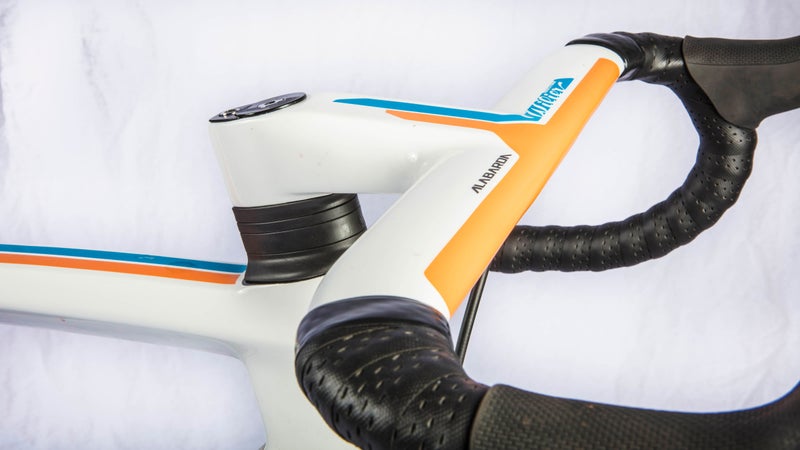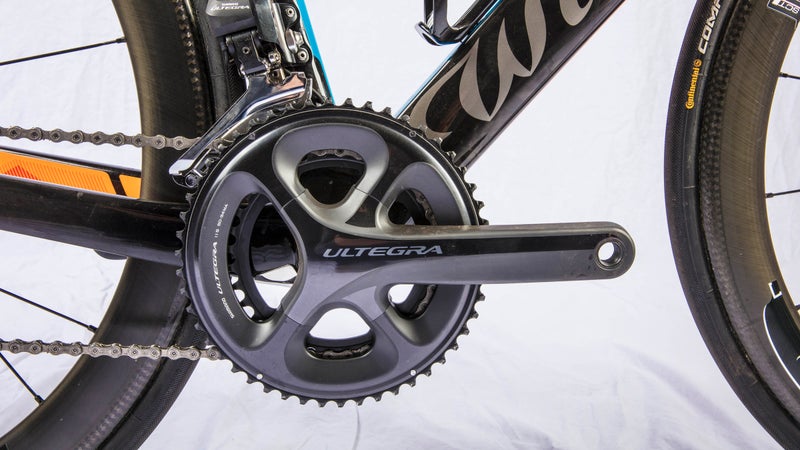The Good: It has a stunning design, including an integrated stem and handlebars. It feels snappy and chipper for an aero machine. And direct-mount brakes allow for up to 28c tires, because not every day is race day.
The Bad: As you’d expect, the race orientation lands it on the stiff end of the continuum. The Hed Ardennes tubular wheels that our test bike came with are supple on the road but get a bit pushed around in crosswinds—and they aren’t very convenient when you flat. Even though we loved the Cento 10’s looks, boo on the Broncos color scheme.
The Verdict: Year after year, Wilier produces some of the least heralded but best loved models in our bike test. Thanks to the aero tubing and lightning-sharp wheels, the Cento 10 Air is blazing fast, with a low weight that allows it to hold its own in the hills. But Wilier really drops the competition by combining that top-notch performance with a gorgeous design and parts pick to create a high-end race bike with more curb appeal than pretty much anything out there.
The Frame

Though the Cento 10 Air is ostensibly derived from Wilier’s first-gen aero machine, the new model bears little resemblance to the original. Tubing gets Kamm-tail shaping, with an air-slicing front edge but a squared-off trailing edge to save weight and smooth airflow. Like many time-trail designs, the seat-tube junction is dropped, and all tube junctions have been optimized to cheat the wind. Other aerodynamic cues include internal cable routing, an airfoil-shaped post, and a collarless, wedge-style seatpost clamp. Wilier claims the design is 8 percent more aero than the previous bike but 200 grams lighter.
The most striking thing about the Cento 10 is the integrated handlebar-stem setup. Both beautiful and functional, the stem features a drop angle that reduces drag, and the bar’s flat tops cut through the wind like an airplane wing. Cables run internally, with brakes sprouting inconspicuously out the bottom of a port in front of the stem (including a nifty hidden cable manager) and shifters going straight through the stem and into the frame. The design is offered in six reach and drop variations, and spacers afford 30 millimeters of height adjustment. All said it’s the sleekest, most practical integration we’ve seen.
The Components

Wilier’s approach to components is somewhat unconventional—and welcome. Instead of inflating full-bike prices further with top-of-the-range components and wheels, the company offers the Cento 10 Air with Ultegra Di2 ($6,400) or standard Dura-Ace ($6,950), both of which come with workhorse Shimano RS21 hoops. The thinking is that most racers probably already have race-wheel preferences, so there’s no need to saddle them with another pair (and an exorbitant price tag to match). Ultegra Di2 components are as fast and accurate as Dura-Ace Di2; the only real drawback is a nominal weight penalty. And for those after a nicer build, a frameset is available for $4,450 (or $3,750 minus the integrated bar-stem).
Stiff and virtually indestructible, Shimano RS21 wheels make for a fine training set. However, on our build we upgraded to Hed Ardennes tubulars, because we figured the deeper rims would better complement the frame’s aerodynamics. Indeed, those wheels were a pleasure to ride, accelerating surprisingly quickly and holding speed admirably on flats and rollers. And while I generally dislike rim brakes on carbon wheels, the power and modulation here was some of the best I’ve experienced, probably due in part to the direct-mount brake design.
The Ride

The first thing you notice after climbing on the Cento 10 is probably the last thing you’d expect on an aero bike: it’s light, just 15.3 pounds for our size large, which is downright willowy given the huge tubing and junctions. (Claimed frame weight is a reasonable 990 grams.) Despite its aero advantages, that made the bike feel like an all-arounder. I rode it on a hard group ride that included a 4,000-foot hill climb and was shocked at the quick turnover and light feel on the ascent, even with those deep rims. The only drawback was the unwrapped, blade-flat bar tops, which were slippery and somewhat uncomfortable on the way up.
Of course, the aero advantages are intended for flat or transitional terrain, and the bike was blistering there, too. It held speed in the flats and gained it more quickly than other bikes when the hammering began. Descending was noticeably quick, too—a good tuck left the rest of the crew behind, flapping in the wind.
The magic of the Cento 10, then, is that it’s blindingly quick but feels balanced and capable on pretty much any terrain. It’s definitely a race bike, with an aggressive stance and hard-edged feel to match. But while the bike is stiff, it isn’t not or abrasive like some dedicated aero models.
The Competition
Though it’s an excellent bike, the Cento 10 Air has heavy competition from both the Trek Madone and the Scott Foil. The Madone probably has a more compliant feel, though our testers thought it wasn’t as snappy as the Wilier. Meanwhile, the Scott is a bit harsher than, but just as chipper as, the Cento. All three are excellent machines, but thanks to the Cento 10 Air’s timeless lines, snazzy graphics, and matching parts, it pips the other two at the line. Having said that, it’s also more expensive, so you’re paying for those looks.
Buying Advice
If I were looking for a single bike to race, the Cento 10 Air would top my list. It’s an absolute joy to ride and a magnet for attention—more than once, cyclists flagged me down to ask what I was riding. The one thing that held it back was the lack of a disc-brake option, though many racers won’t care about that. If Wilier had shipped the Cromovelato Azzuro frame, an eye-popping chrome blue color scheme with blaze yellow accents, I probably would have felt compelled to buy this bike.

